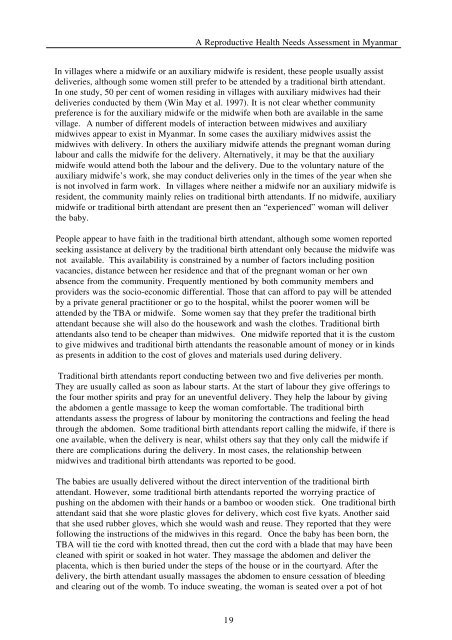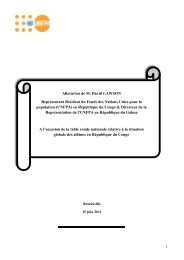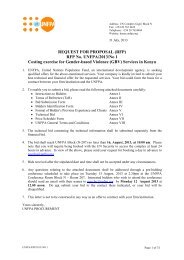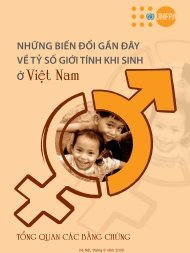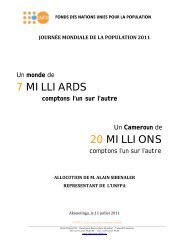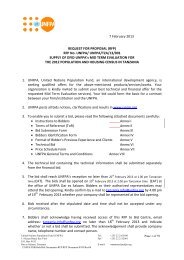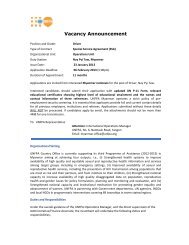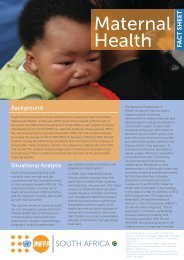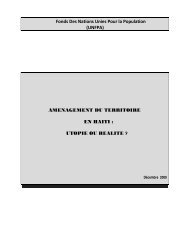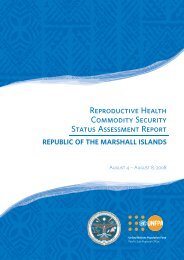A reproductive health needs assessment in Myanmar
A reproductive health needs assessment in Myanmar
A reproductive health needs assessment in Myanmar
Create successful ePaper yourself
Turn your PDF publications into a flip-book with our unique Google optimized e-Paper software.
A Reproductive Health Needs Assessment <strong>in</strong> <strong>Myanmar</strong><br />
In villages where a midwife or an auxiliary midwife is resident, these people usually assist<br />
deliveries, although some women still prefer to be attended by a traditional birth attendant.<br />
In one study, 50 per cent of women resid<strong>in</strong>g <strong>in</strong> villages with auxiliary midwives had their<br />
deliveries conducted by them (W<strong>in</strong> May et al. 1997). It is not clear whether community<br />
preference is for the auxiliary midwife or the midwife when both are available <strong>in</strong> the same<br />
village. A number of different models of <strong>in</strong>teraction between midwives and auxiliary<br />
midwives appear to exist <strong>in</strong> <strong>Myanmar</strong>. In some cases the auxiliary midwives assist the<br />
midwives with delivery. In others the auxiliary midwife attends the pregnant woman dur<strong>in</strong>g<br />
labour and calls the midwife for the delivery. Alternatively, it may be that the auxiliary<br />
midwife would attend both the labour and the delivery. Due to the voluntary nature of the<br />
auxiliary midwife’s work, she may conduct deliveries only <strong>in</strong> the times of the year when she<br />
is not <strong>in</strong>volved <strong>in</strong> farm work. In villages where neither a midwife nor an auxiliary midwife is<br />
resident, the community ma<strong>in</strong>ly relies on traditional birth attendants. If no midwife, auxiliary<br />
midwife or traditional birth attendant are present then an “experienced” woman will deliver<br />
the baby.<br />
People appear to have faith <strong>in</strong> the traditional birth attendant, although some women reported<br />
seek<strong>in</strong>g assistance at delivery by the traditional birth attendant only because the midwife was<br />
not available. This availability is constra<strong>in</strong>ed by a number of factors <strong>in</strong>clud<strong>in</strong>g position<br />
vacancies, distance between her residence and that of the pregnant woman or her own<br />
absence from the community. Frequently mentioned by both community members and<br />
providers was the socio-economic differential. Those that can afford to pay will be attended<br />
by a private general practitioner or go to the hospital, whilst the poorer women will be<br />
attended by the TBA or midwife. Some women say that they prefer the traditional birth<br />
attendant because she will also do the housework and wash the clothes. Traditional birth<br />
attendants also tend to be cheaper than midwives. One midwife reported that it is the custom<br />
to give midwives and traditional birth attendants the reasonable amount of money or <strong>in</strong> k<strong>in</strong>ds<br />
as presents <strong>in</strong> addition to the cost of gloves and materials used dur<strong>in</strong>g delivery.<br />
Traditional birth attendants report conduct<strong>in</strong>g between two and five deliveries per month.<br />
They are usually called as soon as labour starts. At the start of labour they give offer<strong>in</strong>gs to<br />
the four mother spirits and pray for an uneventful delivery. They help the labour by giv<strong>in</strong>g<br />
the abdomen a gentle massage to keep the woman comfortable. The traditional birth<br />
attendants assess the progress of labour by monitor<strong>in</strong>g the contractions and feel<strong>in</strong>g the head<br />
through the abdomen. Some traditional birth attendants report call<strong>in</strong>g the midwife, if there is<br />
one available, when the delivery is near, whilst others say that they only call the midwife if<br />
there are complications dur<strong>in</strong>g the delivery. In most cases, the relationship between<br />
midwives and traditional birth attendants was reported to be good.<br />
The babies are usually delivered without the direct <strong>in</strong>tervention of the traditional birth<br />
attendant. However, some traditional birth attendants reported the worry<strong>in</strong>g practice of<br />
push<strong>in</strong>g on the abdomen with their hands or a bamboo or wooden stick. One traditional birth<br />
attendant said that she wore plastic gloves for delivery, which cost five kyats. Another said<br />
that she used rubber gloves, which she would wash and reuse. They reported that they were<br />
follow<strong>in</strong>g the <strong>in</strong>structions of the midwives <strong>in</strong> this regard. Once the baby has been born, the<br />
TBA will tie the cord with knotted thread, then cut the cord with a blade that may have been<br />
cleaned with spirit or soaked <strong>in</strong> hot water. They massage the abdomen and deliver the<br />
placenta, which is then buried under the steps of the house or <strong>in</strong> the courtyard. After the<br />
delivery, the birth attendant usually massages the abdomen to ensure cessation of bleed<strong>in</strong>g<br />
and clear<strong>in</strong>g out of the womb. To <strong>in</strong>duce sweat<strong>in</strong>g, the woman is seated over a pot of hot<br />
19


